|
 |
|
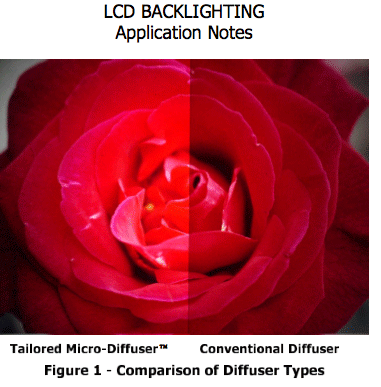 Tailored Micro- Diffuser Technology Tailored Micro- Diffuser Technology
Tailored Micro-Diffusers™ (TMDs), manufactured by Wavefront Technology Inc. (WFT), are surface-relief microstructures that are embossed from holographically recorded master tools and which have almost completely tailorable flux output patterns. As a result of their correlated micro-structured pattern, TMDs demonstrate superior brightness and uniformity in backlights for notebook computer screens and avionics displays when compared to conventional diffusers (see Figure 1 above – Rose Photo taken at 45° from normal). WFT manufactures TMDs in a wide range of angular diffusion patterns which impart virtually no color distortion to the original light source (typically florescent lamp or LED), and exhibit high transmission or forward scattering efficiency (88%+) even for wide diffusion angles. When used to replace the conventional diffuser in a LCD backlight, the TMD™ is also capable of adding gain output into a narrower angular distribution. It should be noted that this effect is achieved without the use of additional prismatic brightness enhancement films, and thus is a very desirable characteristic which will be examined more fully in later sections of this application note.
Because TMDs are composed of surface-relief micro-structured patterns, they can be easily replicated onto low-cost polymer materials. In large quantities, roll-to-roll mass production techniques insure that WFT’s TMD™ costs to OEM manufacturers are well within the range of thosefor consumer product applications. The physicalproperties and performance characteristics ofTailored Micro- Diffusers™ are superior to those of standard diffusers used in LCD backlightingapplications, and in many ways superior to themore costly holographic volume phase diffusers. Tailored Micro- Diffusers are manufactured typically on a thin polymer film substrate, and consequently have a rough side (i.e. the micro-structured surface) and a smooth side (the pristine side of the polymer film substrate). The interaction of light sources with the rough side and smooth side of Tailored Micro- Diffusers™ is markedly different and will be examined in some detail in the material which follows.
As an example, when a relatively collimated light source is incident upon the micro-structured surface (the rough side), the resulting output beam is expanded in angular spectrum and has an output flux pattern consistent with the type of Tailored Micro- Diffuser™ used. This pattern can be centrally symmetric, elliptically symmetric, or somewhat asymmetric.
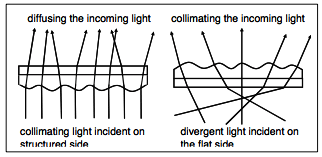 Figure 2 - Diffuser Asymmetry
Figure 2 - Diffuser Asymmetry |
|
Significant gain can be achieved in LCD backlighting applications when a wide-angle Tailored Micro- Diffuser™ is illuminated by a Lambertian source from the smooth side, as for example with a florescent lamp or wave guided light pipe source. As a result of using the TMD™ to replace a conventional diffuser, the light flux emitted from the aperture of the LCD is actually concentrated into a narrower angular spectrum, with enhanced luminance and a field of view which is tailored to match the requirements of the user(s). In general, the wider the diffusion angle of the TMD™ when illuminated with collimated light from the rough side, the narrower the angular distribution is when the TMD™ is illuminated with a Lambertian light source from the smooth side (see Figure 2). This even includes a flipping of the major and minor axes for elliptical diffusers. For illuminated from the smooth side by a Lambertian light source, will result in the major axis being flipped, i.e. it will generate an elliptical output luminance pattern which now has its major axis oriented along the horizontal direction.
It should be noted, that this smooth side orientation of the TMD™ to light source also provides for the widest acceptance angle from a structured Lambertian light source such as a serpentine lamp or the dot pattern from the wave guide of the notebook computer backlight. As a consequence, this architecture allows the TMD™ diffuser to be placed as close as possible to the source while still smoothing the underlying lighting features to those of a uniform plane of light. TMDs and BEFs The brightness enhancing mechanism of the Tailored Micro-Diffuser films, which results from its ability to restrict the angular distribution of the backlight, can be compared to that of the well-known prismatic brightness enhancing films, such as 3M's brightness enhancement films (BEFs). Because of the fundamental difference in their underlying architectures, TMDs have a number of backlight applications in which their performance and/or characteristics are superior to BEF films. Likewise, because of the synergistic interaction between these two types of films, there are many applications in which these two films may be combined to produce an LCD backlight that has superior performance and characteristics than either of the films could produce individually.
The brightness enhancing mechanism of BEFs relies on total internal reflection (TIR) of light incident on the smooth side of the prism film normal. The source of light smooth side of the prism film musdiffuse recycler of this TIR light ithe brightness enhancement takthese conditions are present, the brings light back to the smooth side of the prism film at higher incident angles that can then escape via refraction from the front prismatic surface nearer the local surface normal.
The light path through and performance of the Tailored Micro- Diffuser™ film is significantly different from that of the prism film. To understand this difference, consider that 75 to 80% of the light incident at any angle to the smooth side of the TMD™ film is transmitted through the micro-structured side on the first pass, without being reflected and subsequently having to be recycled. This should be compared to the approximate 50% first pass transmission for the standard 90° prism angle film currently in use in many LCD displays. The holographically generated surface relief pattern of the TMD™ diffuses nearly on-axis input light efficiently into its tailored output field of view, but also refracts off-axis light into an angular spectrum closer to the surface normal. As a consequence, significant on-axis brightness enhancement is achieved without the high degree of reliance on an efficient optical recycling cavity as is required for the prism film. However, it is to be noted that since 20-25% of the incident light to the smooth side of the TMD™ is diffusely reflected, additional brightness enhancement can be achieved with the use of an efficient recycling light source system. The angular distribution of the Tailored Micro-Diffuser™ film is a design parameter with a great deal of flexibility, unlike the angular distribution of a prismatic film which is basically determined as a result of the prism angle and Snell’s Law. Further, the angular output of the TMD™, when used in the brightness enhancing configuration, results in a gentle roll-off of luminance at larger output angles. This is in marked contrast to the very sharp angular cut off of many prismatic films.
TMDs in LCD Backlight
In most single-viewer applications, the requirements are maximum luminance within a relatively narrow field of view and a sharp cut off to minimum luminance outside this field of view. Typical examples would be for LCD displays in single seat tactical aircraft or driver-side automotive LCD displays under high ambient lighting conditions. In these cases the combination of prismatic films with a Tailored Micro Diffuser™ (in place of the conventional diffuser that would typically yield the desired performance. Here some examples of applications with TMD™ diffuser with various angular performances are presented as following:
I. High FWHM TMD™ Diffusers
For TV and avionic applications, typically an array of light sources is applied in a direct-lit architecture. These light sources can be cold fluorescent lamp or LEDs. Diffusion plates or diffuser films are usually utilized to hide the array and achieve a uniform backlight. The high FWHM TMD™ diffusers (FWHM≥60º) offer superior hiding- power and collimation power, which results in good color mixing and high optical gain on the on-axis performance. Figure 3 demonstrates the ability of the high FWHM TMD™ diffuser, when it is oriented with the smooth side toward the Lambertian light source, to restrict the resulting angular distribution and as a result increase the on-axis brightness of the display into the normal field-of-view for the observer.
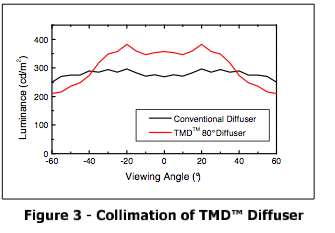 II. Medium FWHM TMD™ Diffusers II. Medium FWHM TMD™ Diffusers
The TMD™ diffusers with medium FWHM(FWHM~30º-50º) are suitable for applications withBEFs. For a typical edge-lit light guide plate, thelight emits at a high angle (~60º), which does notmatch the redirecting condition of BEFs. A TMD™can be applied to bend the light distribution nearnormal (~40º), therefore matches the redirecting condition of BEFs. The operation principle of aTMD™ diffuser as a bottom diffuser is illustrated in Figure 4. The optimal TMD™ diffuser may vary depending on the optical characteristics of the light guide plate. But the FWHM falls in the range of 30º-50º generally since both the bending power and the on-axis recycling are essential. The high FWHM TMD™ diffuser reduces the recycling efficiency of BEFs and is not suitable for this application. In this case, the viewing volume of the backlight is mainly determined by the optical properties of BEFs.
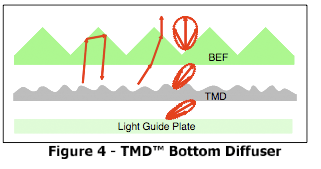 III. Low FWHM TMD™ Diffusers III. Low FWHM TMD™ Diffusers
Moiré effect occurs in LCDs when the prismatic film (BEFs or reversed prismatic film, see Figure 5) contacts the LCD panel since linear structures on prismatic films interfere with the pixel structure of the LCD panel. The superposition of two spatial frequencies forms a series of observable fringes. This undesired moiré pattern severely deteriorates the quality of the display. In order to eliminate the moiré effect, a top diffuser with a suitable haze level (low FWHM) is placed between the LCD panel and the prismatic film as shown in Figure 5.
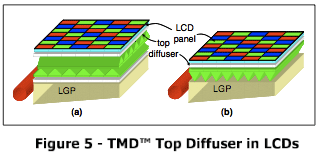 For configuration with BEFs shown in Figure 5(a), TMD™ Diffuser has a better optical effect with conventional top diffusers with a low haze level. However, for configuration with a V-cutting light guide plate and a reversed prismatic film shown in Figure 5(b), the application of TMD™ Diffuser is more beneficial. The reason is that the viewing-volume of the backlight is elliptical [shown in Figure 6(a)] instead of symmetric like configuration with BEFs. The application of conventional or circular TMD™ diffusers as top diffuser results in undesired viewing-volume broadening on the minor axis [Figure 6(b)] therefore the reduction on the on-axis brightness. A suitable elliptical TMD™ diffuser to match the minor axis of the light distribution can eliminate the moiré effect as conventional diffuser and avoid the undesired reduction on brightness [Figure 6(c)]. Besides, if the major axis of the elliptical TMD™ diffuser matches the minor axis of the light distribution, we are able to tune the viewing-volume as shown in Figure 6(d). For configuration with BEFs shown in Figure 5(a), TMD™ Diffuser has a better optical effect with conventional top diffusers with a low haze level. However, for configuration with a V-cutting light guide plate and a reversed prismatic film shown in Figure 5(b), the application of TMD™ Diffuser is more beneficial. The reason is that the viewing-volume of the backlight is elliptical [shown in Figure 6(a)] instead of symmetric like configuration with BEFs. The application of conventional or circular TMD™ diffusers as top diffuser results in undesired viewing-volume broadening on the minor axis [Figure 6(b)] therefore the reduction on the on-axis brightness. A suitable elliptical TMD™ diffuser to match the minor axis of the light distribution can eliminate the moiré effect as conventional diffuser and avoid the undesired reduction on brightness [Figure 6(c)]. Besides, if the major axis of the elliptical TMD™ diffuser matches the minor axis of the light distribution, we are able to tune the viewing-volume as shown in Figure 6(d).
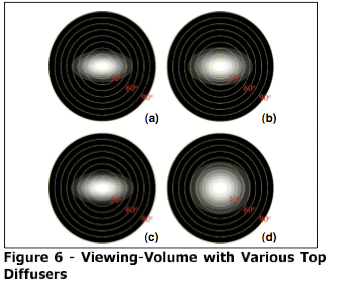 Diffusers Wavefront technology Inc. has demonstrated significant improvement in the brightness and uniformity of LCD backlights, for both direct-lit and edge-lit backlights. This was accomplished by simply replacing the existing conventional diffuser in the backlight assembly with a Tailored Micro- Diffuser of appropriate angular properties. Theapplications of Tailored Micro- Diffusers are nolimited by the shown examples. Diffusers Wavefront technology Inc. has demonstrated significant improvement in the brightness and uniformity of LCD backlights, for both direct-lit and edge-lit backlights. This was accomplished by simply replacing the existing conventional diffuser in the backlight assembly with a Tailored Micro- Diffuser of appropriate angular properties. Theapplications of Tailored Micro- Diffusers are nolimited by the shown examples.
The seller will refund or replace any materials found to be defective. The seller shall not be liable in contract or in tort for any injury, loss, or damage, whether direct, indirect, incidental, special or consequential, arising out of use of or the inability to use the product.
|
|